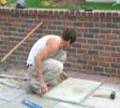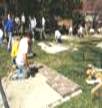Installing Natural Bluestone Pavers
Introduction to Bluestone Pavers
Bluestone pavers are an essential natural material that can be used on many outdoor applications. These applications include driveways, patios, balconies, walkways, sidewalks, and garden paths. Bluestone pavers are best suited for the outdoors because they need to breathe in fresh air. With the fresh air they receive, it helps them beautify with age and last the length of time. They offer a high amount of durability, and stability. |
 |
BLUESTONE PAVERS INSTALLATION GUIDE
Step 1: Materials Needed
Firstly, you will need Bluestone pavers. Pavers are normally sold by a square foot. It is important to measure your specific area and convert it into footage.
Helpful Tip: Always purchase 10 to 15 percent more than you need to allow for breakages, future damages, wastage and wrongful cutting.
Other important materials include:
- Paver base example: mortar, cement, gravel or sand.
- Edge restraints
- Shovel
- Masonry saw
- Wheelbarrow
- String
- Chisel
- Hammer
- Wet Cutting Blade
- Level
- Broom
Step 2: Excavation
 |
Preparing the site firstly starts with the excavation. Once you have chosen the site clear it of any unwanted disturbances such as statues, gardens, or trees. Then you can start to dig the surface. If you’re excavating walkways, sidewalks and patios sites you should be digging at least 4 inches into the ground. If you are excavating a driveway site you should double the digging amount to 8 inches. |
Step 3: Apply the Paver Base
Bluestone pavers can be installed onto beds of mortar, cement, gravel or sand. Mix and prepare the base ready for application. Start in a corner. Apply the base at about 2 inches deep.
Helpful Hints: If your gravel base is dry apply water to help you evenly spread it out.
If using sand try to keep it free of any water. If using mortar or cement start in a corner and apply pavers as you go along
Step 4: Laying the Pavers
Bluestone pavers are commonly purchased in squared and rectangular shapes. This will help with the laying patterns. It is best to start laying pavers one at a time in rows going from left to right. Use your level and strands of string to prepare and help you lay a straight line. If you are applying your bluestone pavers onto a sand base using a soft head hammer give them a slight hammer to position them in their place. |
 |
Helpful Hints:
1. Start the laying process in the far corner and work your way towards the front of the application. This gives you plenty of space to work as you do not want to get yourself caught. 2. Clean all pavers free of any marks as bluestone pavers once sealed marks can not be removed. 3. Edge restraints can be used in between the gaps and on edges. |
 |
Step 5: Cutting Pavers to Size
 |
Once you have completed laying the pavers along the edges, there are always a few pavers that need to be shaped differently. Using the full size pavers place them in position and mark out where they need to be cut. Once this is done place it into position and continue with the rest. |
Step 6: Cleaning
Once the pavers are in place and the job is near completion using a broom sweep over the Bluestone pavers, ensuring that the pavers are free of dirt, sand, and any other unwanted marks or stains.
Step 7: Filling the Joints
If edge restraints are in place remove them and start applying sand to the pavers. Sweep them sand over thoroughly ensuring that it completely fills in all the gaps.
Helpful Hints:
1. Sweep over the pavers several times. Your aim is for the pavement to be interlocked by the sand.
2. Grout can also be used to fill in the gaps. But it is wise to seek manufactures advice when it comes to choosing grout for your bluestone pavers
Cleaning and Sealing
Bluestone pavers are slip resistant, freeze thaw cycled, and hard wearing. They can be sealed to achieve a shiny outlook. They are also easily cleaned by using warm soapy water. If you end up with stubborn and unwanted stains diluted acid can be used to remove the stains.





